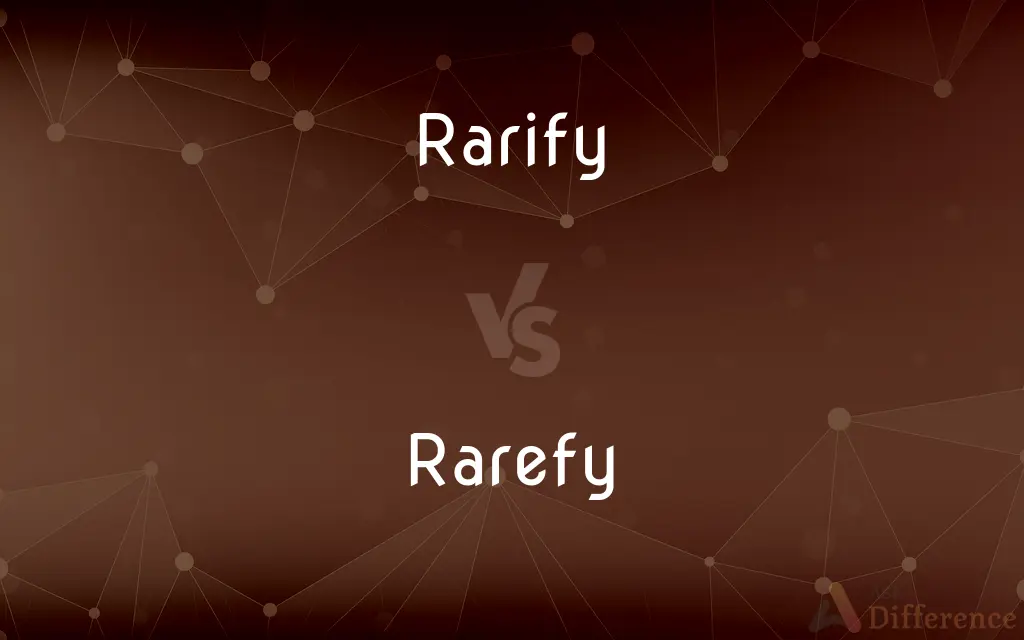Rarify vs. Rarefy — What's the Difference?
Edited by Tayyaba Rehman — By Maham Liaqat — Updated on April 2, 2024
Rarify means to make something rarer or less dense, while rarefy is to make less dense or more refined.

Difference Between Rarify and Rarefy
Table of Contents
ADVERTISEMENT
Key Differences
Rarify is often used in contexts relating to making something less common or more exclusive, emphasizing a decrease in availability or an increase in scarcity. On the other hand, rarefy typically refers to the process of making a substance less dense, such as by reducing its pressure or concentrating its more refined elements.
The term rarify can be applied in economic or social contexts, suggesting the act of making goods, services, or experiences more luxurious or harder to obtain. Whereas, rarefy is frequently used in scientific or technical discussions, particularly in physics and chemistry, to describe the physical process of decreasing density.
Rarify might be employed to describe efforts in marketing or collecting where the goal is to increase value through scarcity. For example, limited edition releases of products are rarified to enhance desirability. Rarefy, however, would be used to describe a process like the rarefaction of air, where air becomes thinner at higher altitudes.
In literature or cultural analysis, rarify could be used to discuss the process of making themes, ideas, or language more exclusive or refined. Meanwhile, rarefy could describe the refinement of substances or concepts, focusing on their essence being distilled or made purer.
Despite their distinct uses, both rarify and rarefy convey a process of transformation towards lesser density or greater exclusivity. The choice between them depends on whether the focus is on physical density and refinement (rarefy) or on scarcity and exclusiveness (rarify).
ADVERTISEMENT
Comparison Chart
Definition
Make something rarer or less common
Make less dense or more refined
Common Usage
Economic, social contexts
Scientific, technical contexts
Example Context
Marketing, collecting to increase value
Physics, chemistry to describe decreasing density
Focus
Scarcity, exclusiveness
Physical density, refinement
Outcome
Increased value through scarcity
Essence distilled, made purer
Compare with Definitions
Rarify
Enhance value by scarcity.
The rarified air of luxury brands sets them apart.
Rarefy
Refine or purify.
The chef's technique rarefied the flavors of the dish.
Rarify
To make less common.
The artist's decision to limit prints rarified her work.
Rarefy
Lighten or etherealize.
The artist's use of light rarefied the painting's texture.
Rarify
Concentrate quality.
The curator rarified the exhibit by selecting only top pieces.
Rarefy
Distill to essence.
The poet rarefied her language, leaving only the most impactful words.
Rarify
Elevate status.
The rarity of the gem rarified its appeal.
Rarefy
To make less dense.
The process was designed to rarefy the gas for the experiment.
Rarify
Increase exclusivity.
Limited access rarified the club's membership.
Rarefy
Decrease pressure.
The laboratory equipment rarefies air to simulate high altitudes.
Rarify
Variant of rarefy.
Rarefy
Make or become less dense or solid
Air rarefies and degrounds the physical body
As the shell continues to expand and rarefy, astronomers may eventually be able to see characteristic gamma rays from the radioactivity within
Rarify
Alternative spelling of rarefy
Rarefy
To make thin or less dense, as air.
Rarify
Make more complex, intricate, or richer;
Refine a design or pattern
Rarefy
To purify or refine
"The [medieval] Italians ... rarefy the image of the lady, treating her as a quasi-celestial figure" (Marcia L. Colish).
Rarefy
To become thin or less dense.
Rarefy
To make rare, thin, porous, or less dense
Rarefy
To expand or enlarge without adding any new portion of matter to.
Rarefy
To make rare, thin, porous, or less dense; to expand or enlarge without adding any new portion of matter to; - opposed to condense.
Rarefy
To become less dense; to become thin and porous.
Rarefy
Lessen the density or solidity of;
The bones are rarefied
Rarefy
Make more subtle or refined
Rarefy
Weaken the consistency of (a chemical substance)
Common Curiosities
What does rarefy mean?
Rarefy means to make something less dense, more refined, or purified.
Can rarify and rarefy be used interchangeably?
While they have similar sounds, they are used in different contexts and are not generally interchangeable.
How does rarefaction relate to rarefy?
Rarefaction is the result of the process of rarefying, especially in terms of reducing density or pressure in a substance.
What does it mean to rarify something?
To rarify something means to make it rarer, less common, or more exclusive.
What industries might use the term rarefy?
Industries like chemistry, physics, and culinary arts might use the term rarefy to describe processes of purification, refinement, or reduction in density.
Can a concept or idea be rarified?
Yes, concepts or ideas can be rarified, meaning they are made more exclusive or refined in their expression or understanding.
Does rarefy always involve a physical process?
Rarefy often involves a physical process but can also refer to the conceptual refinement or distillation of ideas.
Are there ethical considerations in rarifying products?
Ethical considerations can arise when rarifying products, as it may involve creating artificial scarcity or exclusivity that affects accessibility.
How is rarify used in marketing?
In marketing, rarify is used to describe making a product or experience more exclusive or scarce to increase its desirability.
Can a service be rarified or rarefied?
A service can be rarified by making it more exclusive or scarce, but rarefied would typically not apply unless referring to the refinement of the service’s delivery or quality.
How do rarify and rarefy affect value?
Rarify can increase value through scarcity and exclusiveness, while rarefy can enhance value by refining or purifying a substance or concept.
How does one achieve rarefaction in a scientific experiment?
Rarefaction in a scientific experiment is achieved through processes that reduce the density or pressure of a substance, often using specific equipment or conditions.
Is rarify commonly used outside economic contexts?
Rarify can also be used in cultural or social contexts to describe making ideas, language, or themes more exclusive or refined.
How do rarify and rarefy impact consumer perception?
Rarify can make consumers view a product or experience as more valuable due to its scarcity, while rarefy can enhance perception through refinement or quality improvement.
Can the atmosphere be rarified?
The term more commonly used for describing the atmosphere becoming less dense at higher altitudes is rarefied.
Share Your Discovery

Previous Comparison
Digoxin vs. Digitalis
Next Comparison
Wandering vs. WonderingAuthor Spotlight
Written by
Maham LiaqatEdited by
Tayyaba RehmanTayyaba Rehman is a distinguished writer, currently serving as a primary contributor to askdifference.com. As a researcher in semantics and etymology, Tayyaba's passion for the complexity of languages and their distinctions has found a perfect home on the platform. Tayyaba delves into the intricacies of language, distinguishing between commonly confused words and phrases, thereby providing clarity for readers worldwide.
















































